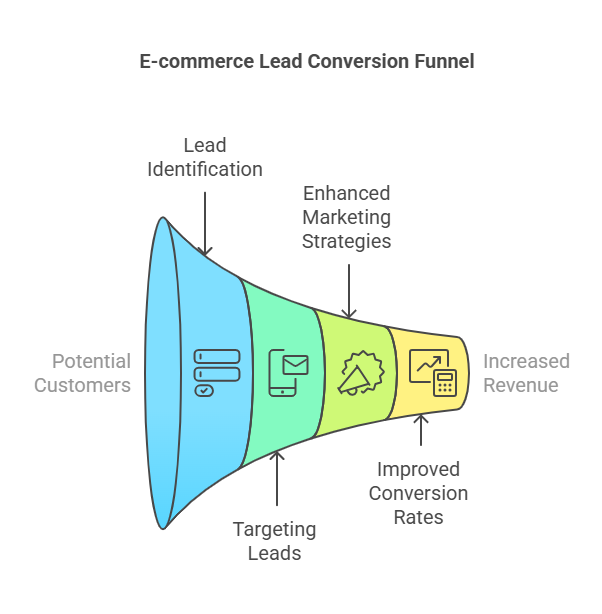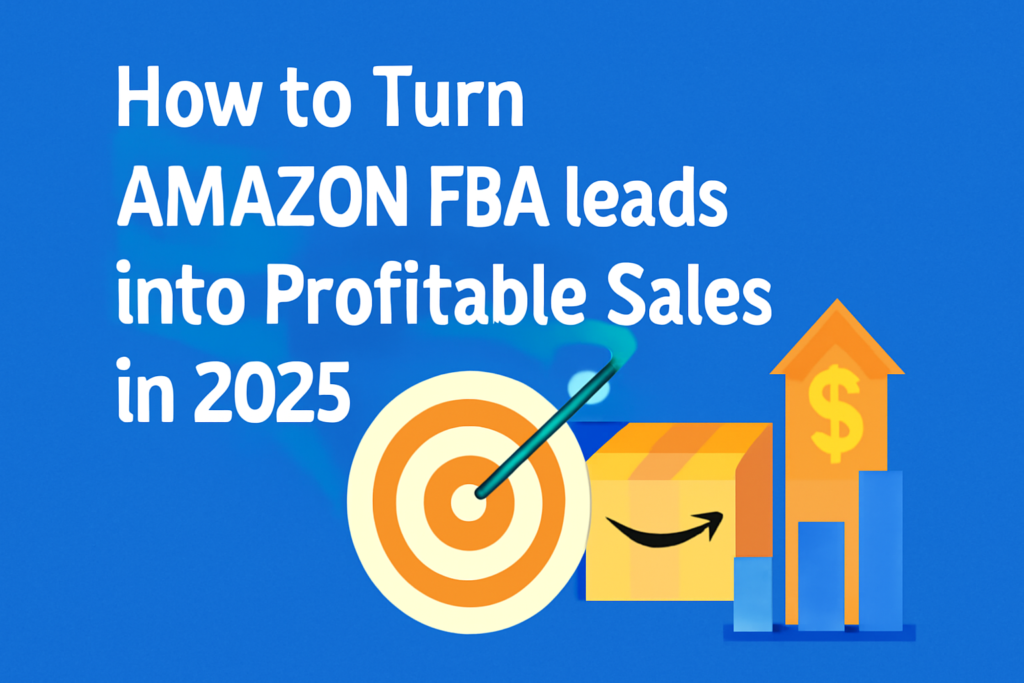Generating high-quality leads is the backbone of any successful eCommerce business. Whether you’re an ambitious store owner striving to expand your customer base or a marketing agency eager to land new clients, finding reliable leads can be a game-changer for growth.
For eCommerce businesses, marketing agencies, and service providers, the hunt for qualified leads often feels like navigating a crowded marketplace. The constant challenge is identifying prospects who not only fit your target audience but are ready to take action. It can be overwhelming to sift through endless options without a clear strategy in place.
We’ll dive into actionable strategies and useful tools tailored to help eCommerce store owners, marketers, and service providers generate quality leads and grow their businesses.
You’ll have a solid roadmap to start attracting the right customers and clients for your business.
Why Finding E-commerce Leads is Crucial ?

For E-commerce Store Owners:
New customers are the lifeblood of any e-commerce business. Without a steady influx of fresh leads, even the best products can struggle to achieve sustained growth. Lead generation plays a pivotal role in increasing sales, improving brand visibility, and expanding customer reach.
When e-commerce store owners continuously attract new leads, they not only boost their sales figures but also ensure long-term profitability.
According to Shopify, stores that invest in lead generation are 80% more likely to scale successfully over time.
For Marketing Agencies:
For marketing agencies, finding new clients is critical to expanding their portfolio and maintaining consistent revenue streams. The competition in the digital space is fierce, and agencies that fail to generate new leads risk stagnation.
A steady flow of new e-commerce clients allows agencies to diversify their offerings, expand their customer base, and build a reputation for delivering results. Marketing agencies that master lead generation can offer more specialized services, increasing their chances of long-term growth.
Studies show that agencies with effective lead-generation strategies see a 25% increase in client retention and satisfaction.
For Service Providers:
Service providers, such as SEO specialists, web designers, and content creators, rely heavily on lead generation to ensure a consistent flow of business. A strong lead-generation process keeps their schedules full and their income stable.
Without leads, it’s difficult to maintain a steady cash flow or sustain growth. Service providers must target businesses in need of their expertise, build relationships, and establish themselves as trusted partners in the e-commerce ecosystem.
In fact, 62% of service providers report that consistent lead generation is the top driver of their revenue growth.
Top Strategies for Finding eCommerce Leads
Here are some proven strategies that can help you discover and attract the right eCommerce leads to boost sales and expand your reach.

1. Optimize Your Website for Lead Generation
A website that effectively captures leads is essential for any eCommerce business. Integrating lead capture systems like pop-ups, contact forms, and clear calls-to-action (CTAs) ensures that visitors can easily engage and convert.
Offering free resources, such as eBooks, guides, or consultations, acts as a powerful lead magnet. These incentives motivate potential customers to share their contact details, creating a valuable database that drives future business growth.
Research shows that 53% of marketers say website optimization is their most effective strategy for lead generation.
2. Use LinkedIn to Connect with Potential Leads
LinkedIn provides an excellent platform for connecting directly with eCommerce store owners and decision-makers. Use LinkedIn’s search functionality to identify businesses that align with your services. Send personalized outreach messages to engage prospects and start building relationships.
The key is to focus on quality over quantity—targeting businesses that could benefit from your solutions increases the chances of meaningful connections. According to HubSpot, 80% of B2B leads come from LinkedIn, making it a vital tool for networking and lead generation.
3. Run Targeted Ads on Social Media (Facebook & Instagram)
Facebook and Instagram offer robust targeting features that allow you to focus on eCommerce business owners, marketing managers, and other decision-makers.
By easily defining demographics, interests, and behaviours, you can ensure your ads reach those who would benefit most from your services. Incorporating lead forms directly within the platforms streamlines the process, capturing contact information with minimal friction.
Studies show that 74% of marketers have found social media ads to be an effective strategy for lead generation, making these platforms essential in your outreach efforts.
4. Create and Share Valuable Content
Blogging, case studies, and guides offer immense value to eCommerce store owners. By creating content that addresses common challenges, such as optimizing product listings or improving conversion rates, you establish authority within the industry.
Sharing helpful, relevant content on your website and through social media channels can draw potential leads directly to you. Companies that prioritize content marketing see 6x higher conversion rates than those that don’t, proving that valuable content is a proven way to attract and engage eCommerce leads.
5. Attend eCommerce Events & Webinars
Attending or hosting webinars and industry events is an excellent way to generate leads while showcasing your expertise. Whether it’s an online webinar or an in-person event, eCommerce conferences, expos, and networking events are filled with potential clients looking for solutions.
By participating in these events, you open up opportunities to engage with decision-makers, exchange ideas, and form relationships that can lead to long-term partnerships.
According to Statista, 63% of businesses that attend webinars report a significant increase in lead generation, demonstrating the effectiveness of this strategy.
| Strategy | Description | Key Tools/Platforms |
|---|---|---|
| 1. Search Engine Optimization (SEO) | Enhance your site’s visibility on search engines with keyword optimization, high-quality content, and proper site structure. This drives organic traffic and attracts potential leads. | Google Analytics, SEMrush, Ahrefs |
| 2. Targeted Paid Advertising | Run strategic ads on Google, Facebook, and Instagram to target specific customer demographics and boost traffic to your eCommerce site. | Google Ads, Facebook Ads, Instagram Ads |
| 3. High-Value Content Creation | Create blogs, videos, product guides, and infographics that educate your audience and address their pain points, establishing your brand as a trusted authority. | WordPress, HubSpot, YouTube |
| 4. Email Marketing Campaigns | Build an email list and send personalized offers, product recommendations, and exclusive deals to nurture leads and encourage conversions. | Mailchimp, Klaviyo, ConvertKit |
| 5. Social Media Marketing | Connect and engage with potential customers on social platforms like Instagram, Facebook, and Twitter by sharing engaging content, promotions, and interactive posts. | Instagram, Facebook, Twitter |
| 6. Influencer Partnerships | Collaborate with influencers in your niche to tap into their audience and boost your brand’s visibility and credibility. | Instagram, YouTube, TikTok |
| 7. Retargeting and Remarketing | Retarget users who previously visited your site but didn’t purchase, bringing them back with personalized ads or email offers. | Google Remarketing, Facebook Pixel, AdRoll |
| 8. Leverage User-Generated Content | Encourage customers to share their experiences with your products through reviews, photos, and testimonials. Display these to build trust and convert more visitors. | Yotpo, Trustpilot, Instagram |
| 9. Affiliate Marketing | Develop an affiliate program where partners earn commissions for referring sales, helping you expand your reach and generate more leads. | ShareASale, Refersion, Rakuten |
| 10. Offer Lead Magnets | Use enticing lead magnets like free trials, eBooks, discounts, or exclusive content to capture email addresses and nurture potential leads into paying customers. | OptinMonster, Leadpages, SumoMe |
Tools and Platforms to Find eCommerce Leads

1. LinkedIn Sales Navigator
LinkedIn Sales Navigator offers advanced search features that help businesses identify key decision-makers in the eCommerce space. By narrowing your search based on factors like industry, company size, and job titles, you can target eCommerce business owners, marketing managers, and other relevant professionals.
With LinkedIn’s InMail, you can directly reach out to potential leads, even if you’re not connected, creating an opportunity for personalized communication.
Research shows that 93% of B2B marketers use LinkedIn to distribute content, making it an essential platform for eCommerce lead generation.
2. Lead Generation Tools (e.g., Hunter.io, Leadfeeder)
Lead generation tools like Hunter.io and Leadfeeder are invaluable for finding and tracking eCommerce leads. Hunter.io helps businesses find email addresses associated with domains, allowing you to connect directly with decision-makers.
Leadfeeder, on the other hand, identifies businesses that visit your website, providing insight into potential prospects who may be interested in your services.
Using these tools, companies can streamline their lead generation efforts, allowing them to focus on high-quality leads. According to Leadfeeder, companies that use their platform see 3-5x more leads than those relying on traditional methods.
3. Web Scraping Tools
Web scraping tools are useful for extracting contact information from eCommerce-specific directories, websites, and online marketplaces. By targeting platforms that list eCommerce businesses, you can gather valuable data on potential leads.
It’s essential to use web scraping ethically, ensuring compliance with privacy laws and website terms of service. With the right approach, web scraping tools can automate lead gathering, saving time and expanding your reach.
According to Forrester, companies that use web scraping for lead generation can increase their outreach efficiency by 40-50%.
4. CRM Systems with Lead Management Features
Customer Relationship Management (CRM) systems are crucial for organizing and managing eCommerce leads. Tools like HubSpot, Salesforce, and Zoho CRM offer features that help track leads through each stage of the sales funnel.
CRM systems allow businesses to automate follow-ups, communications, and reminders, ensuring no lead is left behind. By centralizing all lead information, CRM systems improve team collaboration and make it easier to track performance.
Studies show that CRM systems can boost lead conversion rates by 29% by streamlining the lead management process.
How to Nurture eCommerce Leads Once You Find Them
1. Use Email Marketing
Segmenting your leads into relevant categories is essential for delivering personalized and effective email campaigns. By targeting specific groups, you can send more relevant content, increasing engagement and conversion rates.
For instance, you might tailor campaigns for leads interested in product features, while sending others offers or educational content. Sending lead magnets, such as free resources, exclusive offers, or newsletters, keeps leads engaged and moving through your sales funnel.
Research shows that personalized emails deliver 6x higher transaction rates than generic ones, making email marketing a crucial tool for nurturing leads.
2. Offer Value with Free Trials or Consultations
Offering free consultations or trial services builds trust with potential leads, giving them a risk-free opportunity to experience the value your service provides.
Free trials allow prospects to see firsthand how your product or service can solve their problems, increasing the chances they’ll convert into paying customers.
Providing consultations, whether through one-on-one sessions or group webinars, further helps establish a relationship by offering expert advice tailored to their business needs. According to HubSpot, 40% of businesses report that offering free trials significantly boosts conversion rates.
3. Provide Educational Content and Resources
Keeping leads engaged with continuous value is key to nurturing them over time. Providing educational content through blog posts, eBooks, and webinars helps position your brand as an expert in the eCommerce space. Offering valuable insights or addressing common challenges can keep leads interested in your services while building trust.
Consistent educational content not only strengthens relationships but also helps convert leads into loyal customers. Studies show that 62% of customers are more likely to make a purchase from a company that provides valuable educational content, making it a vital aspect of nurturing your leads.
Common Mistakes to Avoid When Finding eCommerce Leads
1. Focusing Too Much on Quantity, Not Quality
While it’s tempting to collect as many leads as possible, focusing on the volume of leads rather than their quality can significantly lower conversion rates.
A large pool of unqualified leads often leads to wasted time and effort, as these leads may not be ready to buy or may not be a good fit for your service. Targeting fewer, high-quality leads ensures your sales team can focus on prospects who are more likely to convert.
According to Forrester, 80% of sales come from just 20% of leads, proving that quality far outweighs quantity.
2. Neglecting Follow-Ups
Failing to follow up with leads is one of the most common mistakes businesses make when nurturing prospects. A timely follow-up can mean the difference between closing a deal and losing a potential customer.
Leads may not always respond immediately, and without consistent follow-up, you risk missing out on opportunities. Studies show that 80% of sales require at least 5 follow-ups, yet 44% of salespeople give up after just one attempt.
Maintaining consistent follow-up demonstrates your commitment and keeps you top of mind for leads who may need more time or information before converting.
3. Ignoring Personalization
Generic outreach messages are less effective than personalized ones. Understanding a lead’s specific needs and tailoring your message accordingly increases the likelihood of engagement and conversion.
Personalization shows that you’ve taken the time to understand their business, making them feel valued and more willing to move forward with your offering.
Research by Salesforce reveals that 72% of customers expect businesses to personalize communication, and 80% are more likely to make a purchase when the experience is personalized. Crafting personalized messages based on a lead’s interests or challenges can help establish trust and drive stronger relationships.
Conclusion
To effectively find and nurture eCommerce leads, it’s essential to leverage the right strategies and tools.
From optimizing your website for lead generation to using LinkedIn Sales Navigator, targeted ads, and lead generation tools like Hunter.io and Leadfeeder, the right mix can help you attract and convert high-quality leads.
Personalizing outreach, following up consistently, and offering valuable resources like free trials or consultations are also crucial for turning prospects into loyal customers.
Don’t be afraid to experiment with different methods and tools to find what works best for your specific business. Every eCommerce business is unique, so testing and refining your approach will help you uncover the most effective strategies for lead generation.






